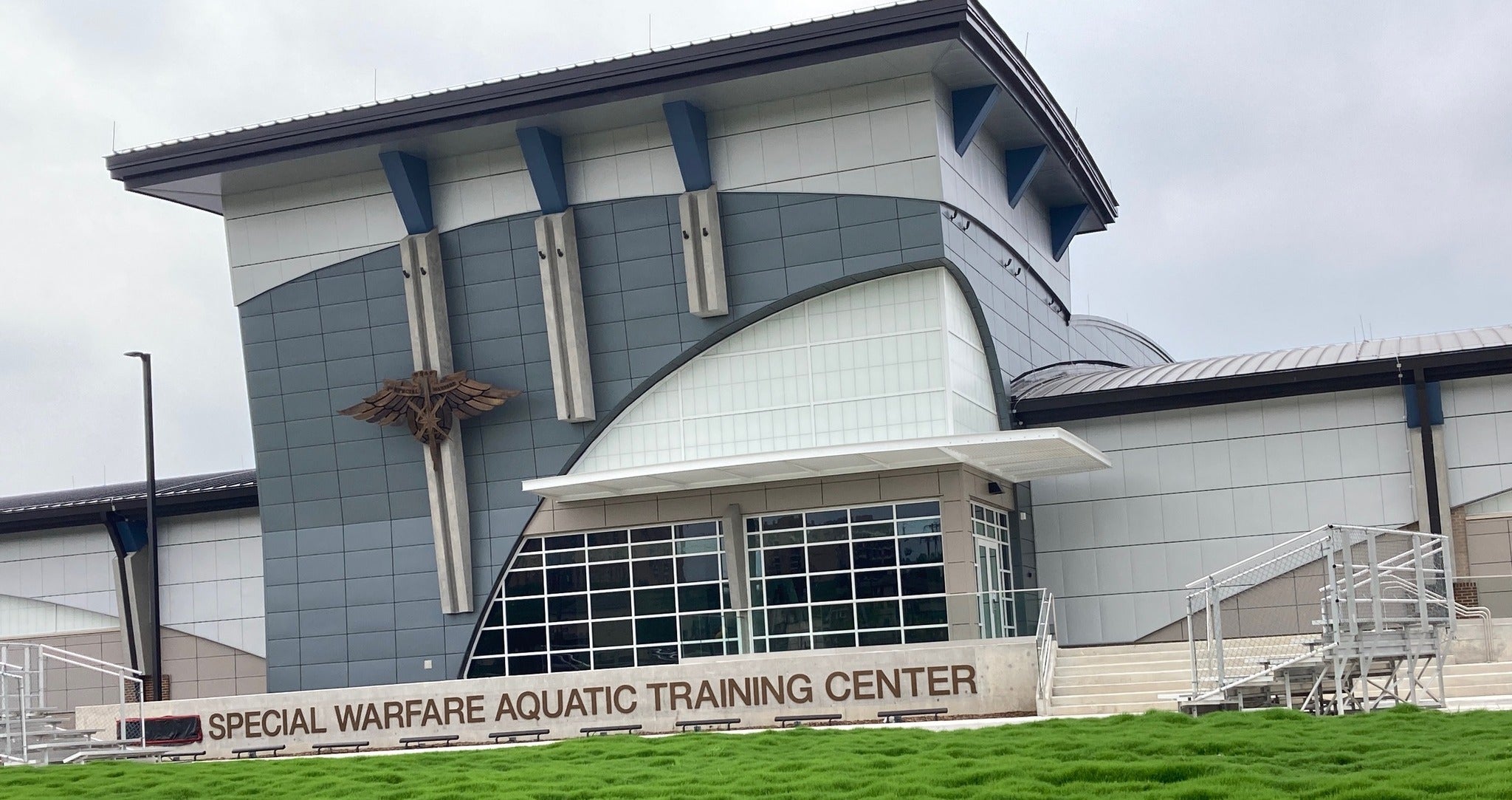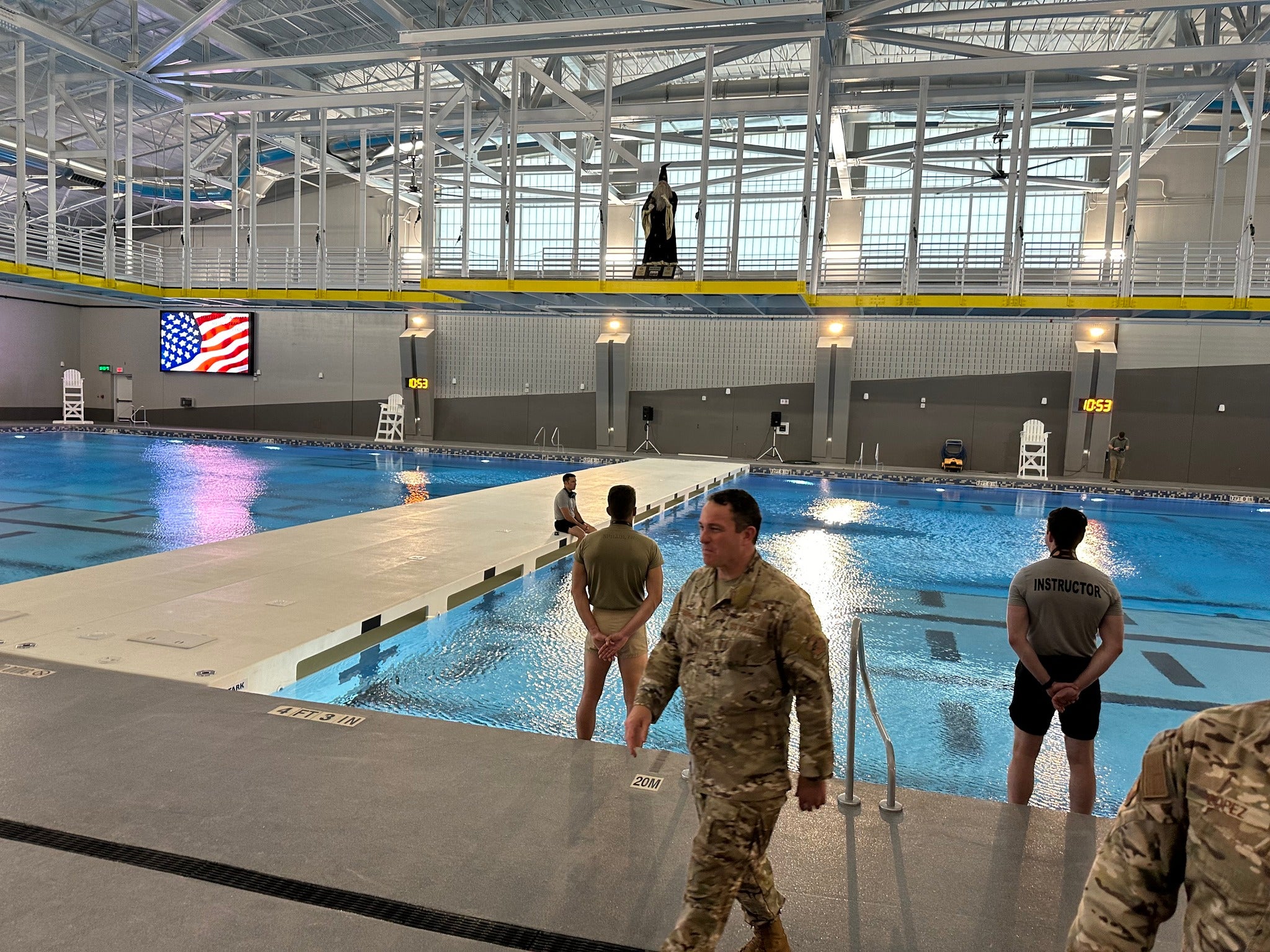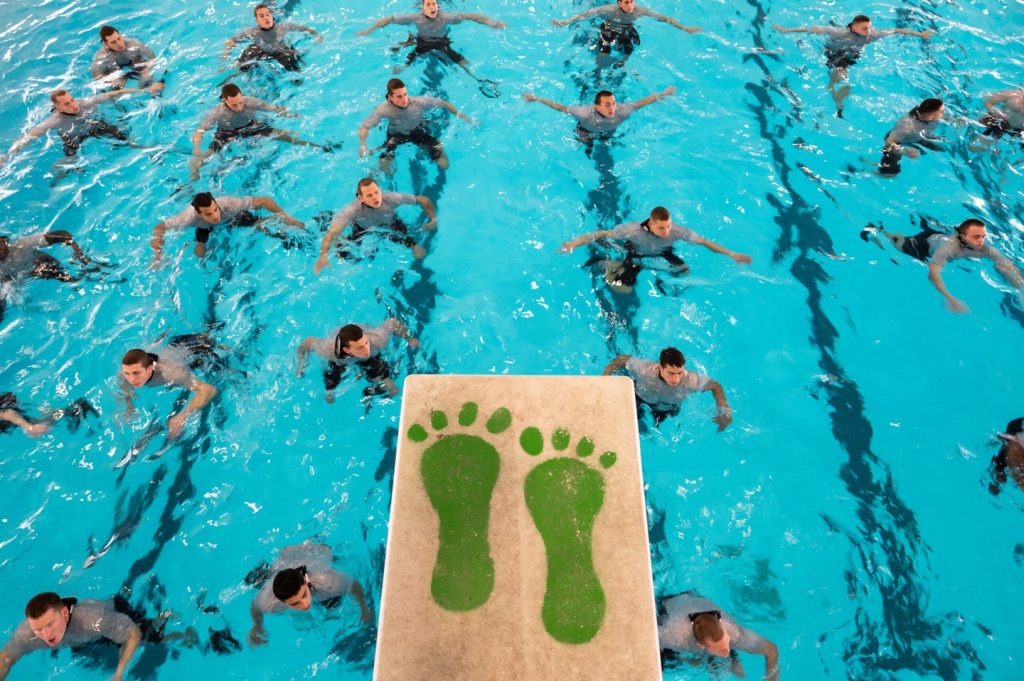Mike Maltz was already a pararescue legend when he submitted his retirement paperwork in early 2003. But within days, he pulled it back, accepting instead a final assignment to lead a team of relatively inexperienced PJs, as Pararescue specialists are known, from the 38th Rescue Squadron on an Afghanistan deployment.
On March 23, 2003, during a mission to retrieve two Afghan children from a remote village, the Air Force HH-60 he was on crashed in a pitch-black valley, killing Maltz and five others.
Tuesday, the Air Force christened the Maltz Special Warfare Aquatic Training Center, a $60 million, 76,000-square foot training hub at Joint Base San Antonion-Lackland. The center houses a 12-foot-deep olympic-sized swimming pool along with medical and therapy facilities, and serve as a training hub for candidates seeking to join the Air Force Special Warfare fields of Pararescue, Combat Control, Tactical Air Control Party or TACP, and Special Reconnaissance.

Pool training has long been at the heart of Air Force Special Warfare selection courses, particularly pararescue and combat control. Students hoping to become PJs and CCTs spend hours each day testing their lung capacity — and mental strength — in a series of increasingly fiendish above- and underwater drills. Though students can swim miles in a day and tread water endlessly, its is the underwater drills that are most dreaded.
In drills known as “water confidence” or “water con,” students swim underwater laps without surfacing, tie knots with with ropes at the bottom of the pool and face so-called “drown proofing” drills, bobbing up and down from the bottom of the pool for a single breath with their hands and ankles tied together.
They also face “buddy breathing,” an underwater wrestling matching between two students sharing a single snorkle, and an instructor. The match has only two rules: students can only take a breath through the snorkle which they share between each other, and they can’t fight back as the instructor pushes them under and twists them in circles.
For decades, Special Warfare airmen have faced all of those drills in a pool on Lackland that doubled as a lap pool in off hours. With the opening of the Maltz center, officials say, the Air Force has a facility to match the training.
According to Rob Disney, a former Pararescue chief who knew Maltz well, naming the center after Maltz is a perfect tribute. To many PJs who joined the Air Force just before 9/11 or in the early years of the wars that followed, Maltz was literally the face of Pararescue — the New York native’s portrait was on the cover of a recruiting brochure used widely for much of the 1990s.
“When I first walked first walked into recruiting office, knowing nothing about Pararescue, I saw mike on the cover of it,” Disney told Task & Purpose. “Before I even thought about being a PJ, my first thought of the job was him.”

Disney, who retired as a chief master sgt. in 2017, said Maltz was well-known among his generation of PJs from his fearsome reputation as an instructor at the school’s selection course in the mid-1990s. Though the school historically could weed out up to 90% of candidates (a rate that has improved in recent years), surviving a Maltz-era class was a particular point of pride. Students who did told stories of Maltz throwing mattresses out of windows during dorm inspections and rappeling from the roof of dorms to surprise — and punish — students who thought they had escaped his gaze.
Class cartoonists — a tradition in Pararescue training — regularly drew scenes of an enraged Maltz pushing students through endless pool workouts and PT ‘smoke sessions.’
Maltz had just left the school when Disney arrived as a student.
“I heard about him, of course,” Disney said. “And I saw the cartoons the earlier classes left behind, and you think, ‘who is this crazy guy?’ So when I finally met him, I’m expecting this guy to be an axe murderer.”
In fact, said Disney, when he reported to his first assignment at Moody Air Force Base, he found Maltz was the most welcoming and friendly there — in his own way.
“On my first day, we went in to the scheduling office where Maltz was, and I see him there,” Disney recalls. “He yells out with that New York accent, ‘you Disney? I think your name is pretty goofy.’ And then he laughs at his own joke.”
From that moment on, said Disney, Maltz was a warm friend. Born to a family with a tradition in law enforcement and fire fighting, Maltz was quick to banter and taunt — he took to addressing Disney as “Bobby,” a name Disney has never gone by — but eager to pass on his decades of knowledge and experience to a new generation. Unlike many senior NCOs, Disney said, Maltz relished challenging younger PJs in top physical shape to keep up with his own manic workouts.
“He’d pull up his shirt all the time and say, ‘hey, Bobby, you ever seen abs like this on a 40 year old man?’” Disney remembered.

As a field operator, some of Maltz’s rescue missions still ring out in PJ lore. On a mountaineer trip to Alaska in the 1980s, he led a team that summitted Denali, then while descending came across two German climbers who had fallen ill at 20,000 feet — a death sentence under normal conditions. Maltz tied the climbers to himself and walked them off the mountain, a rescue credited as the then-highest ever recorded in North America.
Maltz also was a one of the U.S. military’s premier freefall jumpmasters, helping develop Pararescue ocean jump procedures still used today. Maltz also had thousands of jumps as a civilian parachutist. The same intensity he brought to terrorizing students, Disney said, made him an exceptional leader. He knew every regulation, and demanded every member of his team know them too, along with tiny details most missed.
On one deployment, Maltz told his young assistant team leader to unlock a padlock that secured the team’s rifles in a rack. When Maltz checked the padlock and found that the younger man had left the padlock’s dials in place on the unlock code, Maltz chewed the younger PJ out.
“With a PJ team, he was extremely meticulous about organization,” Disney said. “Whether organising an equipment bay, or a deployment schedule, everything had to be in its place. He had a little saying, and he was so friendly with people he’d even introduce himself to strangers with it: ‘Hi, I’m Mike Maltz, I’m a pararescuemen, we’re in town putting apples with apples and oranges with oranges.’”

In 2003, Maltz considered retiring, even putting in for formal retirement orders, but changed his mind for a chance to lead a team in combat. Assigned to rescue helicopters in Kandahar that flew under the callsign “Komodo,” Maltz partnered with Senior Airman Jason Plite, a new PJ who at 21 was half Maltz’s age. On March 23, 2003, Maltz and Plite launched onboard Komodo 11 for a call came of two Afghan children who needed to evacuated from a clinic deep in the Hindu Kush.
Disney, by coincidence, also flew on the mission, as part of PJ jump team on the HC-130 tanker assigned to refuel Komodo 11 as it flew. The night, Disney said, was so dark that even with night visions equipment, it was nearly impossible to see the surrounding terrain. As Komodo 11 attempted to join up with the tanker to refuel, it suddenly dove away and, within seconds, impacted. The crashed killed Maltz, Plite, Lt. Col. John Stein, 1st Lt. Tamara Archuleta, Staff Sgt. John Teal and Staff Sgt. Jason Hicks.
“He was the most committed, dedicated and skilled PJ I ever knew,” said Disney.
The new training facility is not the first memorial to the Komodo 11 PJs.
Plite’s mother, Dawn, has run a foundation in his name since 2003, awarding close to $200,000 in scholarships to almost 70 seniors at Grand Ledge High School in Michigan, Plite’s alma mater. The fund splits the scholarships between students focused on sports and others focused on arts, both of which Plite embraced in high school.
For the last 15 years, Maltz’s brother, Derek, a career DEA agent, has coordinated an annual memorial workout dubbed the Maltz Challenge, each year dedicated to a list of fallen military members. Special operations units, law enforcement agencies and NFL teams all regularly participate.
But even after a career as a PJ — among the military’s most driven and Type-A personalities — Disney still has trouble expressing the sheer force of Maltz’s personality. He recalled a deployment to Kuwait, pre-9/11, when he and the rest of the team were asleep in tents. But from the team’s common room, he could hear vacuuming — a hopeless task in the desert, but one Maltz had assigned himself to fight insomnia.
Trying to sleep, Disney heard the flap to his tent open, then sensed the figure of Maltz hovering over him.
“Bobby,” Maltz whispered. “You asleep? You sleepin’ Bobby?”
It was, said Disney, close to 3 a.m. Except for Maltz, everyone was asleep, and Disney said so.
In a mocking voice, Maltz shot back in the darkness: “You lazy motherf***er. I guess they don’t make’em like they used to.”
The latest on Task & Purpose
- Air Force special operators must take class before getting shaving waivers
- Camp Pendleton Marines encouraged to fix their own barracks rooms
- 101st Airborne soldiers are first to receive new Next Gen Squad Weapon
- Air Force fires commander of Holloman maintenance group
- Army investigating Nazi imagery on Special Forces patch posted online
The post Air Force dedicates $60 milllion Special Warfare aquatics center to lost pararescueman appeared first on Task & Purpose.
